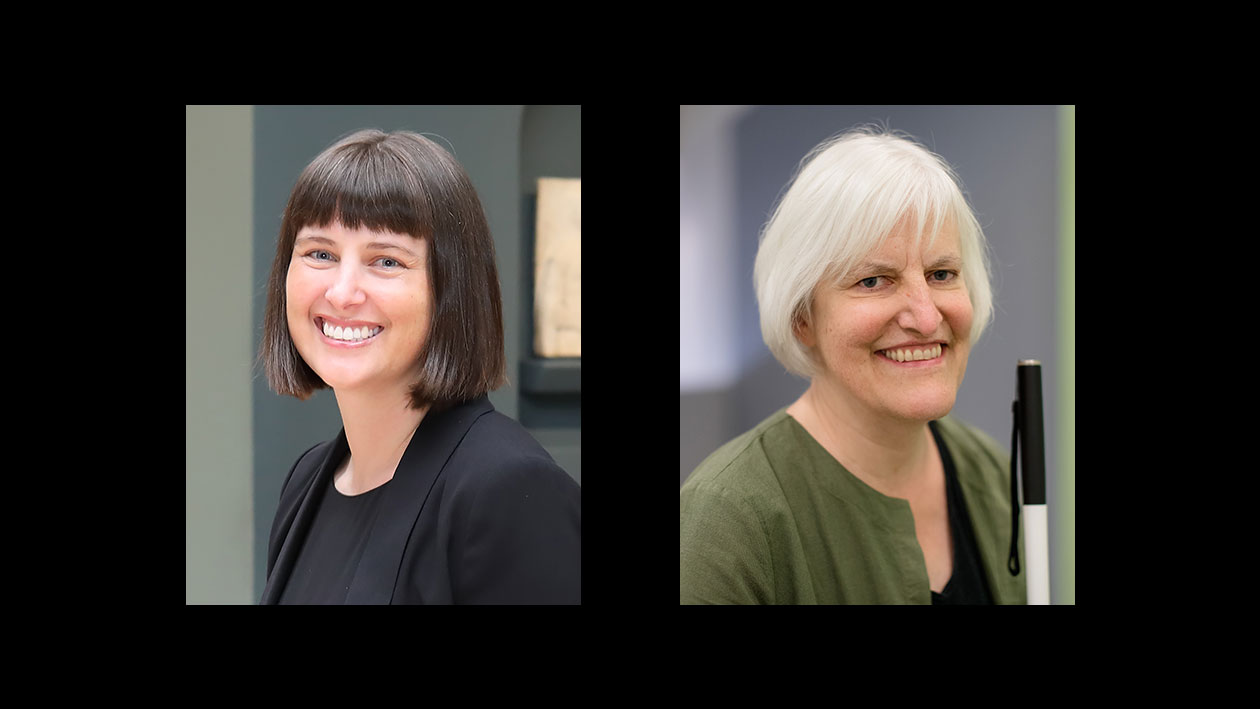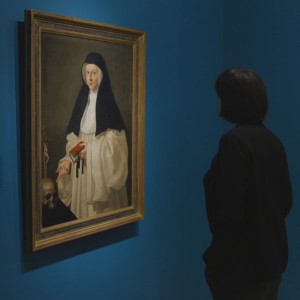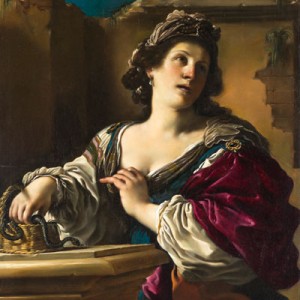Audio: More than Meets the Eye: A Conversation with Georgina Kleege

Audio Series: Touching Art: Embodied Experiences in Museums
Featuring three distinguished speakers from the fields of literature and disability studies, anthropology and education, this series of conversations with Assistant Curator Maggie Bell focuses on how the body shapes engagement with works of art. Building on historical themes addressed in the exhibition The Expressive Body: Memory, Devotion, Desire (1400–1750), the series explores questions of sensory perception, empathy and self-reflection in present-day museum encounters.
More than Meets the Eye: A Conversation with Georgina Kleege
Georgina Kleege is Professor of English at the University of California, Berkeley. In addition to teaching creative writing, Kleege has produced significant publications on the representation of disability in art and literature. Her recent book, More Than Meets the Eye: What Blindness Brings to Art (2018), addresses the history of blindness in visual art, museum accessibility and the enriching experience of engaging with art beyond the sense of sight.
Related conversations in the series:
- Museum of the Senses with David Howes, Co-director of the Centre for Sensory Studies at Concordia University, Montreal
- Learning from the Body with Veronica Alvarez, the Wallis Annenberg Director of Community Arts Partnership at CalArts
Transcript:
Maggie:
My name is Maggie Bell, and I’m an Assistant Curator at the Norton Simon Museum. My current exhibition, The Expressive Body: Memory, Devotion, Desire (1400-1750) explores the physical and emotional impact of representations of the human body, and the historical role of the 5 senses in experiencing works of art. This series of conversations with scholars in the fields of art education, literature and anthropology, brings these themes into the present by addressing the role of the body and the senses in engaging with art today.
I'm so pleased to introduce Georgina Kleege, professor of English at the University of California, Berkeley, where she teaches courses on creative writing, representations of disability and literature and disability memoir, for which she has received distinguished teaching awards. Georgina's own writing, entwines scholarly research, autobiography and cultural critique to explore topics, including the representation of blindness in literature, film and language, biographies of disability icons, such as Helen Keller and the diverse sensory possibilities of engaging with works of art Georgina's approach is often grounded in lived experience and practice apparent in both her writing and collaborations with artists.
Her 2018 book More Than Meets The Eye: What Blindness Brings To Art, addresses the many relationships between blindness and art, including representation, artistic practice, accessibility, and knowledge acquisition beyond the sense of sight. This book has shaped my thinking around multisensory understandings of art both past and present, and is an essential read for all museum practitioners. Georgina, I'm delighted to welcome you to this conversation.
Georgina Kleege:
Thank you, Maggie. I'm very happy to be here with you.
Maggie:
I've gotten so much from your writing on museums and arts engagement and this ranges from so many topics around accessibility and audience participation and practice and navigating museum spaces. And so I want to ask, what has drawn you to museums as a field of research, as a way of thinking?
Georgina:
What draws me to arts museums, I think, is basically a biographical accident that both my parents were visual artists. So although I became blind when I was about 10 or 11, I grew up in the art world in New York. I spent a lot of time in New York art museums and art galleries and artists' studios. So I would claim that I know a lot about visual art, even though I don't see in a normative way. And I think I've always enjoyed art museums.
I mean, it sounds a little sentimental, but I'm really taken with the idea of art museums as sort of palaces for the people. I sort of enjoy the atmosphere of the great museums of the world. So it seems like I've spent a lot of time in art museums and it was really only once, I started writing about my blindness, that I started thinking about visual art and that sort of grew into writing about museum access, the sort of psychological and epistemological and political underpinnings of museum access programs around the world.
Maggie:
I think that's an interesting point. The political function of museums, the social impact that museums can have even in how people navigate these spaces. Is there an expectation placed on visitors in how to engage with art, engage with museum spaces?
Georgina:
Definitely. And I think it's been changing over the decade. I mean, it's always been in process, going back to before there were museums called museums, there were private art collections where privileged people who had art collections would invite visitors to their homes or their galleries and give people an occasion to look or interact with the artwork. And then as museums became public spaces and allowed the public in, the ways that the public was supposed to interact with artwork became very regimented. And basically it became a sort of a vision only procedure and I think that more or less continues to today.
More recently, I think museums have been interested in thinking about different ways for people to interact with art, mainly as a way to bring more people in. If the public is feeling restricted, restrained, you have to move in a certain way, if you're speaking, you should speak in a quiet voice, but maybe more people would want to come into museums if some of those restrictions were lifted or rethought. But definitely I think museums have very specific ideas about who the public is, who is being represented by this institution.
Maggie:
I will say in doing this exhibition, in which I wanted to really talk about this multi-sensory interaction with these works of art, pre-1800, I write a lot about touch and how these small bronzes would've been caressed and handled, and of course our public is completely deprived of the opportunity to do so. that's one of the things that I love about your writing is that for people who can't touch works of art and even as a curator, I don't touch works of art as often as people might think. So I've benefited so much from hearing and reading your descriptions of texture and touching works of art, because it is something that's lost on a lot of viewers. So that leads me to my next question is where is there space for touch in museums and is touch being activated in certain ways?
Georgina:
Well, I would say that touch has a place in museums. I think even in the 19th century, there was this idea of allowing blind people to touch art. So there is sort of in the mindset of museums, the idea that blind people get this privilege. And I'm glad to hear you say that you appreciate what I've written about it because that was sort of the whole point, because I leap at the chance to touch art whenever there's a touch tour available at any museum or gallery or any place that I go. I take advantage, but it always feels a little disappointing. I get something out of the experience but it feels like I have almost an obligation to share that experience with people who don't have that privilege.
I've been encouraging museums to sort of collate and collect the responses of other blind people and maybe make available somehow to the public who don't get to touch, because I will say one thing about any time I've been on a touch tour, where there have been other people around, people really want to know what it's like. Strangers will say, "What does that feel like? What are you getting out of that experience?" I mean, I think everybody, if they had the chance, would want to get their hands on art, but due to conservation concerns that isn't possible. But I think there's a way that information about touch could be included in descriptions of art in collection labels in sort of critical responses to art. So I think it's an untapped resource to talk about the tactile and haptic aesthetics.
Maggie:
Yeah, absolutely. And I think that was something that really struck me about your essay, the art of touch lending a hand to the sighted majority was you offered a kind of toolkit or a way of identifying the types of information that you can acquire through touch. And I was wondering if you could elaborate a bit on how you came to this tool kit, how you identified these different kinds of information.
Georgina Kleege:
A lot of what I've learned in recent years about touching art began with a collaboration with an artist, a visually impaired artist based in Australia, whose name is Fayen d'Evie. I'll spell that, that's D'-E-V-I-E. And we did a number of projects in the San Francisco bay area at different arts institutions. And one of the first things that we discovered was that a work of art, a sculpture tells you how it wants to be touched. So sometimes one feels compelled to touch delicately with the fingertips. Maybe just sort of trace the outlines of the objects. Sometimes you have a feeling that you want to grasp something or manipulate something, make something move, make something happen.
And sometimes the interaction is even pretty rigorous, physical. So that was the first insight we came up with. And then in other explorations, I just started to think about, a lot of times people think that touching a sculpture it's about form recognition. That somehow I'm tracing the outline of this sculpture and it's creating a mental image in my brain. And that may be the case, but it's not necessarily the most interesting thing about touching art, just as looking at a painting or looking at a sculpture is not just about recognizing, oh, that's a horse, or that's a woman sitting in a chair.
I mean, that's not necessarily the point of seeing an artwork. And so similarly with touch, it's not just about identifying what the object is, what's being depicted, but it's also about surfaces, it's about a texture and temperature. It's about density and sonority. That is to say, what happens when you tap or you knock on the surface? Is it hollow? Is it resonant? With larger works of art, it's about how does it cast shadows? How does it affect the airflow around it?
It's also about thinking about the different organs of touch, that touching is not just about the fingertips. It's about the whole hand. It's about the palms of the hands versus the back of the hands. It's about the muscles that you engage with your whole arm, your upper arm. Again, it's about movement, your own movement in relation to the work of art. So there's a lot going on. And in writing about all this, I wanted to avoid this kind of stereotype that, or the myth really that blind people get compensated with extra sensory touch perception, which it's not neurologically true, but I would argue that my experience or experience of other blind people who do this sort of thing, it directs your attention in a different way.
And so I've tried to kind of systematize what I'm doing, what is my approach when I'm given the opportunity to touch a work of art and to sort of have a first and foremost, sort of a sense of what does the sculpture want me to do? And then I have, as you say, a kind of tool kit, a kind of sequence of possible interactions that may yield something interesting.
Maggie:
I was so struck by this, because I'm thinking about my graduate training when I was a teaching assistant. And one of the very first things we would do in intro classes do something called formal analysis. We'd walk our students through how to look at a work of art, how to describe line and color and how these things contribute to meaning in composition. And in reading this essay, it was so obvious to me that how absent other forms of aesthetic appreciation are from teaching. And so I was thinking too, how valuable this kind of toolkit, these strategies would be for early students of art and art history.
Georgina:
Yeah. I'll add to that. I'm coming at this as a blind person, who's made a deliberate... I've educated myself in what I'm doing, but I think also other people, other museum professionals, it could be brought into these conversations. The conservation people know a lot about the touch aspects of all types of art. And they're really interesting people to talk to. Art handlers, the people who carry the stuff around and hang it on the wall, or put it on a plinth or whatever, they know a lot about these issues.
I've had the experience of touch tours in museums. A lot of times they only have the touch tours on days when the museum is closed. And I think they do that really, because if someone sees somebody touching the art, everybody wants to touch.
Maggie:
I think that that's so interesting because you've written, and maybe we can get into this now about the separation of touch tours and tours for the blind, from broader museum experiences. And you've written about the issues around not integrating these experiences across the museum public, and so I was hoping you could elaborate a little bit on that.
Georgina:
There's a tension between that museums sort of want to manage different populations. And so what they offer touch tours to blind people, but they want to sort of control it at a special time, or sort of in a special gallery. So there's a feeling of segregation. Okay, this is available to blind people but only on every second Tuesday when the moon is full or whatever. So it's not as if a blind person could just walk into a museum and say, "Okay, let me get my hands on things.”
I know a lot of blind people who are not as enamored of touch tours as I am, because they feel conspicuous. They feel like they don't know exactly what they're supposed to be doing. Sometimes they feel rushed they feel like, "Okay, this is a sort of obligation that museum is offering this to me. And so I have to do it, but I don't know exactly what I'm supposed to be doing here." So it's not as if every blind person immediately has an interest in doing this.
Maggie:
I think the way you describe this mutually beneficial relationship among audiences is I think, so convincing. I'll segue now into your writing on audio tours because that's such an interesting use of the audio tour as a guided touch. I was wondering if you could talk a little bit about the place of audio tours and some of your impressions.
Georgina:
Well I'm very interested in words and images and how they work together or don't work together and is an image worth a thousand words? And what do we do with those thousand words? And I think nowadays audio tours at museums for everybody are so ubiquitous. And then on top of that, there's all sorts of verbal description available on... You can go to the website and get all sorts of verbal description about an exhibit or in specific pieces, so on and so forth.
And all of that is good. Generally speaking, I'm engaged by efforts that bring different perspectives into description. So it's one thing to have the expert perspective of the curator or an art historian or even the artist talking about a work. And that's interesting to me, but I'm also interested to hear other people's impressions. It also speaks to the fact, when I go to museums, typically I'm with people, people I know. And the people I know I go to museums with have some sort of advanced knowledge of what I want to know. So our conversations are very focused, but it would be nice to sort of collect different levels of description.
One thing I've noticed during the pandemic. Of course museums, like everybody else, had to figure out how to do this thing. And so they really amped up their online programming. And I noticed that a lot of museums had gallery talks and curator talks and so on and so forth of collections. And I was amused and pleased to notice that even though they were not necessarily aiming their words at a blind and visually impaired audience, they were employing techniques, the sort of best practices of audio description for blind people. And I think it's because they knew that even the highest resolution digital image of a work of art is not the same as being in person.
So I think going forward, it's useful to think about how can you leverage these practices that came about during the pandemic and use them in ongoing development of audio programming in museums.
Maggie:
Your writing about audio descriptions has shaped my own discussions about my exhibition and teaching more generally, because I think about friends who are lay people when it comes to works of art. And I don't always start with a careful description of the work itself, which is beneficial to everyone. And in fact, as you point out descriptions aren't neutral, they're not a given. And so to present that as my perspective and as you say, even better to incorporate multiple descriptions, it's a really brilliant way to start talking about a work of art for any audience.
Georgina:
I think the whole understanding of audio description is developing, but there was this expectation that somehow you could produce in a objective description and it's impossible. And I don't think it's desire I mean, the first words that come out of your mouth are already interpretation. You say at the center of the image, well, what do you mean at the center in the image? Is it the dead center of the canvas or is it where your eye goes first? And then where your eye goes first is not necessarily where somebody else's eye goes first, I've taught audio description, and I often even as a sort of writing project or a kind of critical thinking project with students, often I'll show an image or there's an image in a book or whatever.
And I'll just ask, "What do you see in this?" And somebody will offer a description. And initially it's sort of about being nice to the blind professor, but pretty soon it gets more... So somebody says, "Oh, I see this and that." And then the next person says, "Oh, I don't know if I'd call it that. I think it's more..." And each person keeps adding some detail and then there's some dispute, and then there's some resolution and somebody's reminded of something else, and people start using metaphors and so on and so forth.
Maggie:
Yes. Yeah, absolutely. And along the lines of this very big topic of the pandemic and how this has changed museum practice so much, we have all moved to the digital, but you pose in more than meets the eye a sort of rhetorical question that if audio guides or maybe by extension, videos, recorded experiences of museum settings, if they're available online, why should a blind person go to the museum? Or perhaps why should anyone go to a museum?
Georgina:
I mean, it's a big question and I know it's a question on the minds of museums around the world because they've been shuttered and now it's like, "Well, do people really want to come back inside?" And if there's all this material available on what websites and so on YouTube, do you really want to go to museums? I mean, for me, as I said before, I like museums. I like the environment. I like the idea of this public's space that somehow belongs to the public.
It doesn't matter how good the digital imagery is. Standing in front of a painting and aware of its size and shape is significant. It's part of the experience of art. The other thing is about engagement with other human beings in three dimensional space.
Maggie:
So I'm going to present perhaps a concluding question, I wanted to ask you if you have a memory of a meaningful personal encounter, physical encounter with the work of art that you'd be willing to share.
Georgina:
It was that MoMA in New York and the way they did touch tours, and I don't know what they're doing now, but they basically, you make a reservation in advance and they assign you your own personal docent, which is very nice because it means that you show up in an appointed time and there was a person, and she was a graduate student at Columbia in art history. And before we did anything, we had a conversation and which was useful for both of us to say, "Here's what I know. Here's what I want us to experience today." So that she could tailor the experience to me. And we were looking at... There's a series of heads, sculptures by Matisse. They're called the Heads of Jeannette was the name of the model.
And there's one that's very representational. It's very naturalistic. And then each of them becomes increasingly abstracted. And the narrative that she told me, which I think is sort of the received knowledge about these pieces is that Matisse was working out how to do abstraction in a two-dimensional projection, so in a painting, but to do that, he wanted to start with a three-dimensional object. And so touching these heads in succession was really very interesting and engaging to me, and sort of to imagine how the artist went from this thing that I could wrap my hands around to then putting it in a two dimensional version.
So I was doing this gesture of where I had my hands around the head, and then I was trying to open up my hands to make them flat, to figure out how he was thinking, and it was pleasurable. I mean, it sounds a little sentimental in a way, but there is a thrill you get when you say, "My hands are where the artist's hands once were." My palms are in the same position that his palms must have been at some point. So the memory of that is still in my hands and it's still very significant and stays with me.
Maggie:
Georgina, thank you so much for taking the time, this was a very meaningful conversation, and you’ve left us with this very productively critical and hopeful view of what museums are and what they can be, so thank you very much for taking the time.
Georgina:
Thank you, Maggie.
Maggie:
This conversation is part of the series Touching Art: Embodied Experiences in Museums, produced in conjunction with the Norton Simon Museum’s exhibition The Expressive Body: Memory, Devotion, Desire (1400–1750), on view October 15th, 2021 through March 7th, 2022.
Additional conversations with David Howes, Co-director of the Centre for Sensory Studies at Concordia University, Montreal and Veronica Alvarez, the Wallis Annenberg Director of Community Arts Partnership at CalArts, are available at nortonsimon.org.






